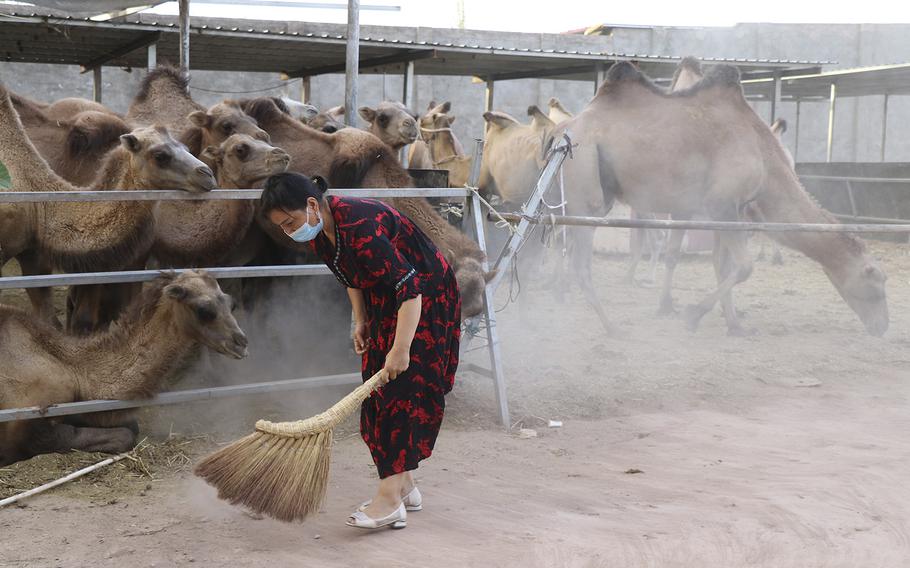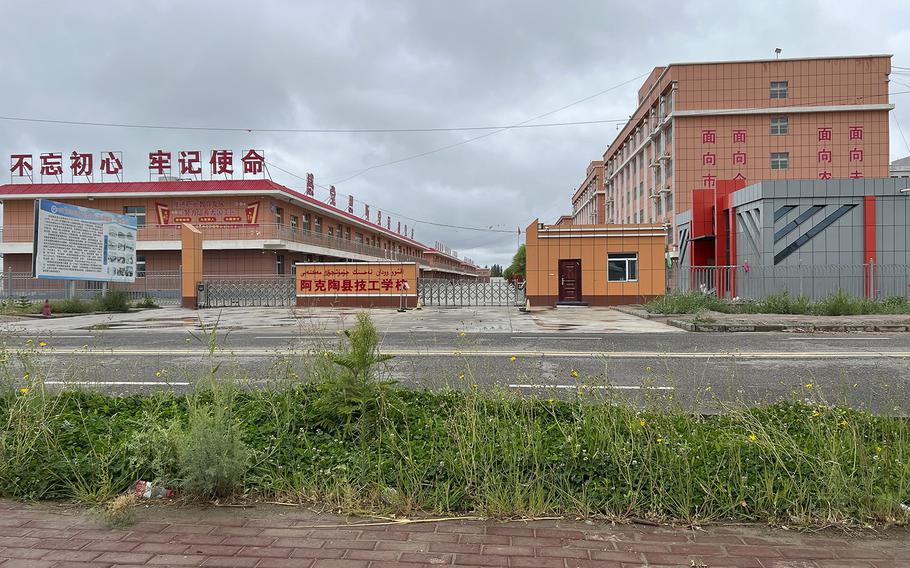
A Chinese tourist holds a baby doll at the end of an imitation wedding performance for tourists in Kashgar on Aug. 3, 2022. (Eva Dou/Washington Post)
KASHGAR, China — A lone guard looks out through the bars of the metal gate onto a dusty village road lined with spindly poplars and marigolds.
The facility inside these peeling, whitewashed walls used to be a "vocational education and training center," local residents say, one of the feared detention camps in China's northwest Xinjiang region where authorities sent Muslim Uyghurs for ideological reformation. Now, it's a coronavirus quarantine center, decorated with colorful murals of doctors and healthy families.
Across Xinjiang, the former reeducation camps stand as ominous warnings for residents to stay in line, while fading into the landscape for outsiders.
A nine-day reporting trip by The Washington Post through the region in late July and early August revealed concerted efforts by Chinese officials to put the crackdown behind them. But even as the most visible security measures have been loosened, Xinjiang residents continue to live under heavier official pressure than in other parts of China.
A long-delayed United Nations report concluded in August that the Chinese government's actions in Xinjiang may constitute crimes against humanity, with "severe and undue restrictions on a wide range of human rights." Beijing maintains it was a justified crackdown on religious extremism and terrorism, and denies reports of torture and mistreatment that the U.N. team found credible.
U.S. officials say it could be a long time before Washington lifts a sweeping trade ban against Xinjiang, China's largest region and the main domestic source of cotton and oil. An international boycott of Uzbekistan cotton because of forced labor remained for 13 years before being lifted in March. U.S. sanctions on arms sales to China, adopted in response to the Tiananmen Square massacre of 1989, remain in force.
The Xinjiang crackdown began in the wake of Chinese leader Xi Jinping's trip to the arid borderland in 2014, which was marred by a knife-and-explosives attack on the Urumqi train station. Xi ordered officials to "strike first" against terrorism. They began broadly rounding up Uyghurs for detention and ideological reeducation in 2016, based on vague and expansive criteria, such as abstaining from alcohol or maintaining contact with overseas relatives.
So far, the campaign has closely tracked the textbook arc of previous crackdowns by the Chinese Communist Party, including intense pressure on local officials to catch every last suspect, mobilization of the public to inform on one another, sweeping detentions, and then the eventual release of most people back into society, with harsh prison sentences for a minority as a warning to the rest.
Now the final stage has begun: An official forgetting. As with the Cultural Revolution of the 1960s, Tiananmen in 1989 and other violent campaigns since, the party is moving to erase traces of its actions in Xinjiang from history.
For Uyghur families ruptured by the crackdown, there is no hope for forgetting, or for a return to normalcy.
Before the crackdown, Uyghurs would gather for evening prayers in the mosque by the Afaq Khoja mausoleum, a holy tomb site for Muslims. On an August evening, the mosque was silent. Instead, a cheerful dance show for tourists was underway in the surrounding gardens.
A female tourist from Henan province, a member of China's majority Han ethnicity, was pulled onstage and a mock wedding to a Uyghur man acted out, with the two tossed in the air in blankets. At the end, a plastic infant was placed in her arms, to the crowd's cheers.
"We just experienced a Uyghur wedding and it's quite humorous," the woman, who did not give her name to The Post, told a domestic TV station after the show.
The scene illustrated the pressures for assimilation in the region, even as the most pointed aspects of the crackdown are scaled down. Many mosques have been razed or shuttered. Few Uyghur men have beards, and few women wear headscarves, after many were detained for modest expressions of faith. Many remain in prison.
Such nuances are lost for the legions of domestic tourists who poured into Xinjiang this summer, part of a patriotic push to shore up the sanctioned region. With information about the brutality of the crackdown strictly censored in China, many Chinese support it. Life in the rest of China has also gotten more repressive in the pandemic, with long lockdowns and intrusive tracking, making some of the policies in Xinjiang seem more normalized to a domestic audience.

A woman sweeps the ground at a camel farm on the outskirts of Kashgar in Xinjiang on Aug. 2, 2022. (Eva Dou/Washington Post)
The notorious official who oversaw the campaign against the Uyghurs, Chen Quanguo, was replaced with a new regional boss in December. The newcomer, Ma Xingrui, 62, hails from the more-liberal coast and has pledged to present a friendlier face for Xinjiang. He has also emphasized adherence to law in speeches to local officials, an apparent nod to international condemnation of the extrajudicial detentions and police brutality.
But even in tourist areas, there were glimpses of elevated pressures on Uyghurs. Cooking knives are still chained to the counters at restaurants. Signs in the backs of taxis remind passengers their conversations are being recorded. Guards carrying machine guns and truncheons watch over Kashgar residents lining up for coronavirus testing.
Outside several mosques, police officers rushed over to demand a Post reporter delete photos, saying it was forbidden to publish images of the religious structures. Such a rule does not exist elsewhere in China.
The "end" of a crackdown is a relative term. Once a cohort has been identified as a potential threat to the party's rule, it never leaves heightened scrutiny. Decades after Tiananmen, pro-democracy intellectuals continue to be closely tracked by Chinese security, with some placed under house arrest each year around sensitive anniversaries. Members of the Falun Gong spiritual movement - who were thrown into labor camps in the late 1990s similarly to the Uyghurs - also remain under close watch today.
All signs suggest that the same will be the case for Uyghurs.
The most reviled part of the crackdown, the reeducation camp program, appears to have ended in 2019 under international pressure. While a comprehensive independent survey of camp sites has yet to be done - Xinjiang is more than twice the size of Texas - scattered checks by journalists since late 2019 have found such sites abandoned or converted.
A Washington Post reporter checked about a dozen sites around Kashgar and Hotan previously identified as reeducation sites in the Xinjiang Data Project, a database compiled by the Australian Strategic Policy Institute. Most of them appeared to be empty or converted, with several sites labeled as coronavirus quarantine facilities, teacher's schools and vocational schools.
At some of the sites, local residents or guards confirmed they were former "vocational education and training centers," Beijing's official term for the reeducation camps, while at others, guards said the buildings had never served a different purpose than their current one. Satellite images show watchtowers, a security feature of detention centers, had been removed from the perimeters of some buildings in 2020.
"As for 'reeducation' - if it is being defined narrowly as the extrajudicial detention of Uyghurs and Kazakhs - it seems to have come to a halt," said Timothy Grose, a Xinjiang expert at the Rose-Hulman Institute of Technology in Indiana. "Certainly, political ideology classes are still being carried out in prisons, factories, local government buildings and homes, so 'reeducation' is ongoing."
Close surveillance of Uyghurs also continues, including through an intrusive program that sends officials for homestays in villagers' homes.
Rayhan Asat, a U.S.-based lawyer, said officials recently visited her parents in Xinjiang and asked them to remind her brother to "study well" in prison. She said this seemed to indicate reeducation continues for prisoners.
Asat has proclaimed her brother's innocence after he was sentenced to 15 years in prison for "inciting ethnic hatred" in the crackdown. As with many cases, there was no sign he had a lawyer for his defense, or court records released, adding to the anguish and fear of his loved ones.
International scholars estimate hundreds of thousands have been imprisoned through courts during the campaign, with likely a larger number held for shorter periods in reeducation centers. Beijing has refused to say how many people were detained. In one of the few official data points, Xinjiang reported 86,655 people receiving prison sentences longer than five years in 2017, many times the figure before the crackdown, in an annual yearbook.
As those with shorter sentences begin to be released from prison, some will be entering a system for their continued monitoring and ideological education.
Xinjiang issued updated guidelines in 2021 for "community corrections," a parole-like program that allows for continued supervision for former prisoners who have completed their sentences. The guidelines specify that ideological education may continue for those who served time for religious-extremism-related offenses.
The Xinjiang government did not respond to a query about how many former prisoners are in the program.
In an industrial park outside the city of Hotan, the sprawling yellow buildings of a former reeducation center stand empty. Down the street, a prison is operating, on a block sealed off with a tall metal gate.
"It's a prison back there," a worker said. "You shouldn't linger around here."
The continued operation of prisons in industrial parks across Xinjiang is one reason human-rights activists say forced labor may still be present in the region, which Chinese authorities deny. Xinjiang also still operates state-organized poverty alleviation labor transfer programs, which the U.N. report flagged as a forced labor risk due to Uyghurs having reported threats if they don't participate.
There are broad implications for China's economy. Xinjiang is a key source of natural resources for China's manufacturing sector. U.S. sanctions on goods linked to the region have snarled international supply chains for fashion, food and solar panels.

A former reeducation center in an industrial park outside Kashgar, in China’s Xinjiang region, appeared deserted Aug. 3, 2022. (Eva Dou/Washington Post)
Firsthand accounts of forced labor from Uyghurs have waned in the past couple of years, and assessing the current situation is difficult. China has made it all but impossible for many Uyghurs to leave the country, confiscating their passports and prohibiting non-emergency travel broadly during the pandemic.
"The full information is extremely limited," said Gheyyur Qurban, head of the Berlin office of the World Uyghur Congress. "People are afraid to go back and can't even reach family members over the phone."
Intense surveillance and intimidation of local residents make it hard to ascertain whether workers are speaking truthfully if they say conditions are fine - or to protect their safety if they report problems. Multiple international auditing firms have pulled out of Xinjiang because of such difficulties, and China kicked out one auditor that wrote an unfavorable report.
Several employees in a textile park in Yarkant County told The Post they were working voluntarily and were satisfied with the pay, while others said they were completing internships as a requirement to graduate from a vocational school, a common source of factory labor across China. Because of the risk of retaliation for Xinjiang residents who speak to international media, a Post reporter did not record the names of those who spoke in brief chats.
At several other industrial parks, officials cited pandemic restrictions in barring access. Police prohibited interviews at an electronics factory located next to a detention center for drug offenders that used to be a reeducation center in Kashgar's Shule County.
There have been some changes, such as the closure of reeducation camps containing factories. Local officials have eased up on rhetoric that unemployment is a sign of extremism. China's National People's Congress ratified the U.N. International Labor Organization's Abolition of Forced Labor Convention in April.
But state-organized labor transfers are continuing in Xinjiang, said Laura Murphy, a human rights professor at Sheffield Hallam University in the United Kingdom.
"Lack of transparency is a major challenge and one reason it took so long for international concern to focus on the region," said Jeremy Daum, a senior fellow for Yale Law School's Paul Tsai China Center. "At the same time, the situation has continued to evolve, in part as a result of this growing attention both in China and abroad."
Clearing up its labor reputation may be a long process for Xinjiang. Under international standards, a supply chain is considered tainted if even a fraction of it contains forced labor.
Thea Lee, deputy undersecretary for international affairs for the U.S. Department of Labor, said in an interview that the eventual goal was remediation and lifting of the sanctions, but it was difficult to see how that was possible while Xinjiang residents face high risk of retaliation for what they say to outsiders. Xinjiang continues to have one of the world's most intensive state surveillance systems, including ubiquitous facial recognition cameras, and databases of residents' voices and iris patterns.
"Even if you talk to a worker outside the workplace, would they be thrown in jail after you left or otherwise disciplined if something came out that was detrimental?" Lee said. "Can people living in Xinjiang speak up without fear of retribution? I think that is going to be the key question."
If Chinese officials look to previous crackdowns, they may conclude the diplomatic fallout is finite and surmountable.
After the Tiananmen Square crackdown, Western nations had also recoiled in horror, cutting business ties and adopting sanctions. Business fallout was mostly short lived, with China emerging as the world's factory floor in the years that followed. The U.S. and European Union arms sales embargoes have remained in place but haven't prevented China's rise as a military power.
China's detention and torture of members of the Falun Gong spiritual movement in 1999 also drew widespread international criticism at the time but has had little long-term effect for Beijing.
What has proven long-lasting is the psychological effects for those targeted. Psychiatrists coined the term "concentration camp syndrome" to describe the long-term mental suffering of survivors of Nazi camps. Similar symptoms have been documented among Vietnam War veterans and those persecuted in China's Cultural Revolution. Researchers have found this trauma does not even end at death, and can be passed from generation to generation.
Gene Bunin, an independent researcher who founded the Xinjiang Victims Database, a crowdsourced list of Uyghur detainees, said the mass detentions have been deeply traumatic for the population, with the long-term consequences unclear.
"You can't just take out such a huge portion of the population and expect things to just go back to normal," he said.
Asat agrees. "It did so much damage to Uyghur people's psyche," she said.
Cadell reported from Washington. The Washington Post's Christian Shepherd, Lily Kuo and Pei Lin Wu in Taipei, Taiwan, contributed to this report.